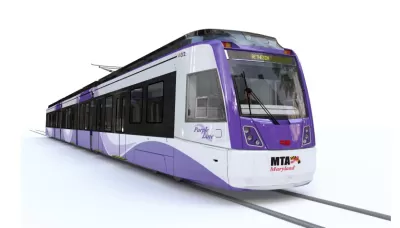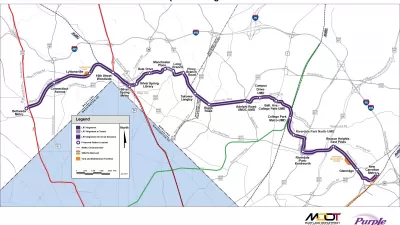A new plan lays out strategies to keep housing affordable for low- and moderate-income residents along the corridor of Maryland’s new Purple Line.

A recently released plan outlines ways to preserve affordable housing and minimize displacement along the route of the Purple Line, a new 16-mile light rail line coming to Maryland. The Purple Line Corridor Coalition is advising leaders and local organizations as the project moves forward on strategies to help ensure that gentrification does not drive up housing costs, particularly in economically distressed neighborhoods along the line.
"The plan makes 12 recommendations for the next three years — most are focused on how to foster housing construction, preserve existing affordable homes and protect vulnerable renters along the Purple Line, which will run between New Carrollton in Prince George’s County and Bethesda in Montgomery County," writes Ally Schweitzer.
The plan notes that half of renter households along the corridor are currently "cost burdened," spending at least 30 percent of their income on housing, and these residents will be vulnerable to housing cost increases when the rail line is completed. "But with construction of the transit line already underway, the plan calls for leaders, nonprofits and private sector leaders to start implementing some of its recommendations now," says Schweitzer.
FULL STORY: How To Limit Gentrification Along The Purple Line, According To Housing Advocates Ally Schweitzer

Trump Administration Could Effectively End Housing Voucher Program
Federal officials are eyeing major cuts to the Section 8 program that helps millions of low-income households pay rent.

Planetizen Federal Action Tracker
A weekly monitor of how Trump’s orders and actions are impacting planners and planning in America.

Ken Jennings Launches Transit Web Series
The Jeopardy champ wants you to ride public transit.

‘Minnesota Nice’ Isn’t so Nice When You Can’t Find a Place to Live
The Economic Development and Housing Challenge Program can help address the scourge of homelessness among Indigenous people.

NYC Open Streets Organizers Call for City Support
The number of open streets projects has dropped year after year as volunteer groups struggle to fund and staff them.

Crime Continues to Drop on Philly, San Francisco Transit Systems
SEPTA and BART both saw significant declines in violent crime in the first quarter of 2025.
Urban Design for Planners 1: Software Tools
This six-course series explores essential urban design concepts using open source software and equips planners with the tools they need to participate fully in the urban design process.
Planning for Universal Design
Learn the tools for implementing Universal Design in planning regulations.
Heyer Gruel & Associates PA
Ada County Highway District
Institute for Housing and Urban Development Studies (IHS)
City of Grandview
Harvard GSD Executive Education
Toledo-Lucas County Plan Commissions
Salt Lake City
NYU Wagner Graduate School of Public Service




























